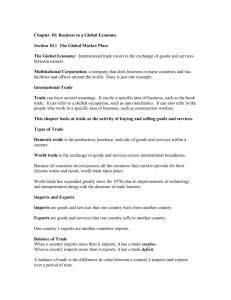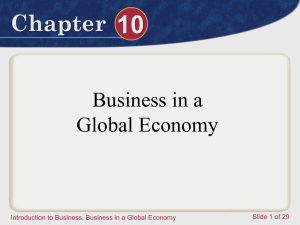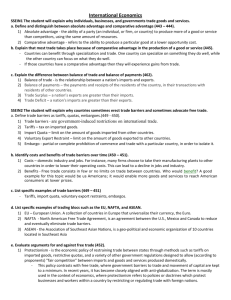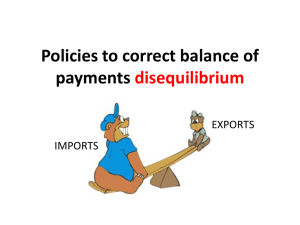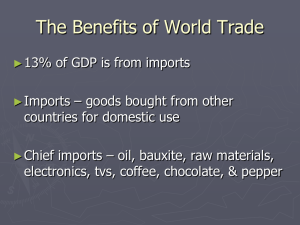Ch 10 PPT
advertisement
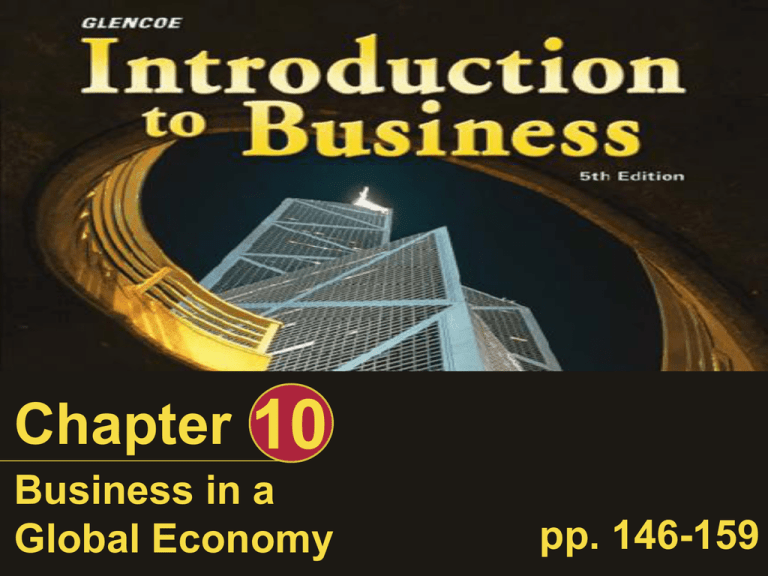
Chapter 10 Business in a Global Economy pp. 146-159 Chapter 10 Learning Objectives After completing this chapter, you’ll be able to: 1. Explain why nations need to trade with each other. 2. Describe how currency exchange works. continued Introduction to Business, Business in a Global Economy Slide 2 of 64 Chapter 10 Learning Objectives After completing this chapter, you’ll be able to: 3. State the advantages of protectionism and free trade. 4. Name types of trade barriers. continued Introduction to Business, Business in a Global Economy Slide 3 of 64 Chapter 10 Learning Objectives After completing this chapter, you’ll be able to: 5. Identify some of the major trade alliances in the world today. Introduction to Business, Business in a Global Economy Slide 4 of 64 Chapter 10 Why It’s Important Global trade doesn’t just influence business, it also affects all the countries and people of the world. Introduction to Business, Business in a Global Economy Slide 5 of 64 Chapter 10 Key Words multinational company imports exports exchange rate balance of trade protectionism continued Introduction to Business, Business in a Global Economy Slide 6 of 64 Chapter 10 Key Words tariff quota embargo free trade Introduction to Business, Business in a Global Economy Slide 7 of 64 Chapter 10 Technology’s Influence on Business We are all part of the global marketplace. The global marketplace exists anywhere business crosses national borders. Introduction to Business, Business in a Global Economy Slide 8 of 64 Chapter 10 Technology’s Influence on Business Countries can satisfy their citizens’ wants and needs by buying them in the global market. Introduction to Business, Business in a Global Economy Slide 9 of 64 Chapter 10 The Global Marketplace A multinational corporation is a company that does business in many countries and has facilities and offices in many countries around the world. Introduction to Business, Business in a Global Economy Slide 10 of 64 Chapter 10 The Global Marketplace The global marketplace works much like a shopping mall or a supermarket. Introduction to Business, Business in a Global Economy Slide 11 of 64 Chapter 10 The Global Marketplace The United States is rich in resources— human, natural, and production—but it still needs things from other countries. Introduction to Business, Business in a Global Economy Slide 12 of 64 Chapter 10 Figure 10.1 MAJOR EXPORTS AND IMPORTS OF THE UNITED STATES Look at the graph to see what products the United States imports and exports. Source: Standard & Poor’s Introduction to Business, Business in a Global Economy Name the product that the United States exports more than it imports. Slide 13 of 64 Chapter 10 Specialization Countries specialize in producing certain goods and services. By specializing, countries can sell what they produce best so they can buy the products they need from other countries. Introduction to Business, Business in a Global Economy Slide 14 of 64 Chapter 10 Specialization The kinds of resources available to a country often influence what it specializes in producing. Introduction to Business, Business in a Global Economy Slide 15 of 64 Chapter 10 Specialization A country with little money or advanced technology but a large population might specialize in manual labor. Introduction to Business, Business in a Global Economy Slide 16 of 64 Chapter 10 Making an Ethical Decision 1. What are the benefits and drawbacks of a global economy for the United States? 2. What are the benefits and drawbacks of globalization for people living in underdeveloped countries? continued Introduction to Business, Business in a Global Economy Slide 17 of 64 Chapter 10 Making an Ethical Decision 3. How can underdeveloped countries break into world markets? 4. Should prosperous, industrialized nations monitor labor issues in other countries? If so, how? If not, who should monitor these issues? Introduction to Business, Business in a Global Economy Slide 18 of 64 Chapter 10 Types of Trade Imports are goods and services that one country buys from another country. Exports are goods and services that one country sells to another country. Introduction to Business, Business in a Global Economy Slide 19 of 64 Chapter 10 Types of Trade Other types of trade include: • Investment • Exchange of human resources • Tourism • Military aid • Loans Introduction to Business, Business in a Global Economy Slide 20 of 64 Chapter 10 Currency Countries have to pay for each other’s products with currency. Currency is another name for money. Just as countries use different languages, they use different currencies, such as dollars, pesos, and yen. Introduction to Business, Business in a Global Economy Slide 21 of 64 Chapter 10 Currency The foreign exchange market is made up of banks where different currencies are exchanged. Introduction to Business, Business in a Global Economy Slide 22 of 64 Chapter 10 Exchange Rates The exchange rate is the price at which one currency can buy another currency. Exchange rates change from day to day and from country to country. Introduction to Business, Business in a Global Economy Slide 23 of 64 Chapter 10 Exchange Rates How much the currency of a country is worth depends on how many other countries want to buy its products. Introduction to Business, Business in a Global Economy Slide 24 of 64 Chapter 10 Prices A company follows the change in exchange rates to find the best prices for products. Introduction to Business, Business in a Global Economy Slide 25 of 64 Chapter 10 Prices When the value of a country’s currency goes up compared to another country’s, it has a favorable exchange rate. Introduction to Business, Business in a Global Economy Slide 26 of 64 Chapter 10 Prices When the value of a country’s currency goes down compared to another country’s, it has an unfavorable exchange rate. Introduction to Business, Business in a Global Economy Slide 27 of 64 Chapter 10 Prices Some countries choose to lower the value of their currency to bring in more business. Introduction to Business, Business in a Global Economy Slide 28 of 64 Chapter 10 Balance of Trade Balance of trade is the difference in the value between how much a country imports and how much it exports. Introduction to Business, Business in a Global Economy Slide 29 of 64 Chapter 10 Balance of Trade When a country exports more than it imports, it has a trade surplus. When a country imports more than it exports, it has a trade deficit. Introduction to Business, Business in a Global Economy Slide 30 of 64 Chapter 10 Balance of Trade A country can have an unfavorable balance of trade with one country and a favorable balance with another. Introduction to Business, Business in a Global Economy Slide 31 of 64 Graphic Organizer Chapter 10 Graphic Organizer How Exchange Rates Affect the Balance of Trade Weak Currency Strong Currency More exports than imports Trade surplus (leftover money) FAVORABLE BALANCE OF TRADE More imports than exports Trade deficit (debt) NEGATIVE BALANCE OF TRADE Introduction to Business, Business in a Global Economy Slide 32 of 64 Chapter 10 Fast Review 1. Give examples of how countries specialize based on the types of resources they have. continued Introduction to Business, Business in a Global Economy Slide 33 of 64 Chapter 10 Fast Review 2. Name types of trade between countries other than imports and exports. 3. Why would a country want to devalue its currency? Introduction to Business, Business in a Global Economy Slide 34 of 64 Chapter 10 Global Competition Global competition often leads to trade disputes between countries. At the heart of most trade disputes is whether there should be limits on trade. Introduction to Business, Business in a Global Economy Slide 35 of 64 Chapter 10 Protectionism Protectionism is the practice of putting limits on foreign trade to protect businesses at home. Introduction to Business, Business in a Global Economy Slide 36 of 64 Chapter 10 Protectionism Some of the reasons in favor of protectionism are: • Foreign competition can lower the demand for products made at home. continued Introduction to Business, Business in a Global Economy Slide 37 of 64 Chapter 10 Protectionism • Companies at home need to be • protected from unfair foreign competition. Industries that make products related to national defense need to be protected. continued Introduction to Business, Business in a Global Economy Slide 38 of 64 Chapter 10 Protectionism • The use of cheap labor in other • countries can lower wages or threaten jobs at home. A country can become too dependent on another country for important products like oil, steel, or grain. continued Introduction to Business, Business in a Global Economy Slide 39 of 64 Chapter 10 Protectionism • Other countries might not have the same environmental or human rights standards. Introduction to Business, Business in a Global Economy Slide 40 of 64 Chapter 10 Trade Barriers To limit competition from other countries, governments put up trade barriers to keep foreign products out. Introduction to Business, Business in a Global Economy Slide 41 of 64 Chapter 10 Trade Barriers A tariff is a tax placed on imports to increase their price in the domestic market. Introduction to Business, Business in a Global Economy Slide 42 of 64 Chapter 10 Trade Barriers A quota is a limit placed on the quantities of a product that can be imported. Introduction to Business, Business in a Global Economy Slide 43 of 64 Chapter 10 Trade Barriers An embargo is when the government decides to stop an import or export of a product. Introduction to Business, Business in a Global Economy Slide 44 of 64 Chapter 10 The Friendly Asian Markets Many Asian markets are friendlier to smaller American companies. Consultant Robert Azar works with U.S. businesses that want to plant roots in Asia. continued Introduction to Business, Business in a Global Economy Slide 45 of 64 Chapter 10 The Friendly Asian Markets According to Azar, Asian businesses may perceive a large company as a threat. In contrast, they often see smaller ones as someone they can join up with. continued Introduction to Business, Business in a Global Economy Slide 46 of 64 Chapter 10 Analyze This is good news for what type of business ownership? Introduction to Business, Business in a Global Economy Slide 47 of 64 Chapter 10 Free Trade Supporters of free trade believe there should be no limits on trade. Introduction to Business, Business in a Global Economy Slide 48 of 64 Chapter 10 Free Trade The benefits of free trade are: • It opens up new markets in other • countries. It creates new jobs, especially in areas related to global trade. continued Introduction to Business, Business in a Global Economy Slide 49 of 64 Chapter 10 Free Trade • Competition forces businesses to be more efficient and productive. • Consumers have more choice in the variety, price, and quality of products. continued Introduction to Business, Business in a Global Economy Slide 50 of 64 Chapter 10 Free Trade • It promotes cultural understanding and cooperation between countries. • It helps all countries raise their standard of living. Introduction to Business, Business in a Global Economy Slide 51 of 64 Chapter 10 Trade Alliances To reduce limits on trade more countries are forming trade alliances with each other. In a trade alliance, several countries merge their economies into one huge market. Introduction to Business, Business in a Global Economy Slide 52 of 64 Chapter 10 Trade Alliances NAFTA (North American Free Trade Agreement) was controversial because some workers would be displaced when trade barriers were lowered. Introduction to Business, Business in a Global Economy Slide 53 of 64 Chapter 10 Trade Alliances Some of the major trade alliances in the world today are: • NAFTA • European Union (EU) • Association of Southeast Asian Nations (ASEAN) Introduction to Business, Business in a Global Economy Slide 54 of 64 Chapter 10 Figure 10.2 MAP OF TRADE ALLIANCES IN THE WORLD The European Union (EU) is the oldest and bestknown economic community formed to promote free trade among the members of the community and to foster common economic policies. What nations make up the European Union? Introduction to Business, Business in a Global Economy Slide 55 of 64 Chapter 10 International Business and Finance Affects Everyone Understanding international business and finance has become increasingly important for the consumer, wage earner, investor, citizen, and business leader. Introduction to Business, Business in a Global Economy Slide 56 of 64 Chapter 10 International Business and Finance Affects Everyone An understanding of international business helps you understand why goods and services are at particular prices. Introduction to Business, Business in a Global Economy Slide 57 of 64 Chapter 10 International Business and Finance Affects Everyone The business leader of tomorrow will have a good grasp of international business and finance. Introduction to Business, Business in a Global Economy Slide 58 of 64 Chapter 10 Fast Review 1. What is a trade war? 2. What are some of the major trade alliances in the world today? Introduction to Business, Business in a Global Economy Slide 59 of 64 Chapter 10 Why do small companies seek to do business globally? continued Introduction to Business, Business in a Global Economy Slide 60 of 64 Chapter 10 How does the cost of natural resources affect the average family? continued Introduction to Business, Business in a Global Economy Slide 61 of 64 Chapter 10 How do affordable, energy efficient homes protect the environment? continued Introduction to Business, Business in a Global Economy Slide 62 of 64 Chapter 10 How can a small company influence the economy of another country? Introduction to Business, Business in a Global Economy Slide 63 of 64 End of Chapter 10 Business in a Global Economy

